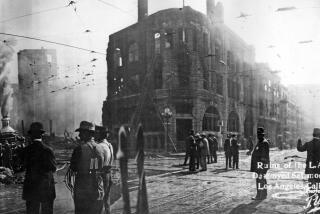Police contend that the battering ram is...
- Share via
Police contend that the battering ram is a victim of its own success. The ram scared rock house operators into closing down.
It was to be a revolutionary new weapon in the war against drugs, one that Los Angeles Police Chief Daryl F. Gates vowed to use “over and over and over again.”
It sparked a storm of protests, inspired a plot line in the television show “Hill Street Blues,” sparked a brief boomlet in pins and bumper stickers and prompted a legal challenge that went all the way to the U.S. Supreme Court.
The subject of all the hoopla and controversy, the mechanized battering ram, has been used on only six drug raids and is rarely taken out of its downtown parking garage nowadays.
It’s been three years since Los Angeles police unveiled the battering ram, a six-ton armored personnel carrier equipped with a 14-foot steel nose for smashing down the walls of rock houses, fortified dwellings where cocaine in solid or “rock” form is sold.
The ram’s debut the night of Feb. 6, 1985, did not go quite as planned. Gates called out the media, christened the tank with a bottle of wine, and rode shotgun as the motorized ram flattened the walls of a heavily fortified Pacoima home.
An undercover officer had earlier purchased cocaine from the house, which was owned by a man who was later convicted of operating other rock houses in the San Fernando Valley.
But that night police found only two very frightened women and three small children amid the rubble. The raid turned up no weapons and only a minute quantity of cocaine. The women said their children had been playing in a front room just before the ram hit, and avoided harm only because they were called into the kitchen to eat ice cream.
A storm of controversy ensued, with religious and community leaders demanding a ban of the battering ram and the American Civil Liberties Union filing a lawsuit to stop its use. The ACLU contended the tank was dangerous and violated state and federal constitutional guarantees against excessive force and unreasonable search and seizure.
In January, 1987, a divided California Supreme Court sharply limited police use of the battering ram, requiring officers to get a judge’s approval before they rolled out the vehicle for raids. The city appealed to the U.S. Supreme Court, which last October let the California court decision stand.
Nowadays, police rarely take the ram out except to display it at police picnics and open houses, said Capt. Pat E. McKinley, head of the Metropolitan Division.
The mechanized ram hasn’t been used in a drug raid since April, 1986. It was last used to knock down a wall last June in South-Central Los Angeles, where a man was barricaded and firing at police. The home’s front wall fell and the man immediately surrendered, said Lt. Jeff Rogers.
Police contend that the battering ram is a victim of its own success. The ram scared rock house operators into closing down, moving their operations outside the city or relocating to second-story buildings beyond the ram’s reach.
Furthermore, police have developed “new techniques and new equipment” to use instead of the ram, Rogers said. But McKinley said the ram is “ready to use again at a moment’s notice” and will be used for future rock house raids.
Police aren’t worried about the need to seek prior approval from a judge, Rogers said, adding: “As a matter of fact, several judges called and said ‘If you need someone to approve the ram, just call.’ ” But one officer, who asked not to be named, said so much paper work is required to get access to the mechanized ram that narcotics officers try to find other ways to apprehend suspects.
More to Read
Sign up for Essential California
The most important California stories and recommendations in your inbox every morning.
You may occasionally receive promotional content from the Los Angeles Times.













